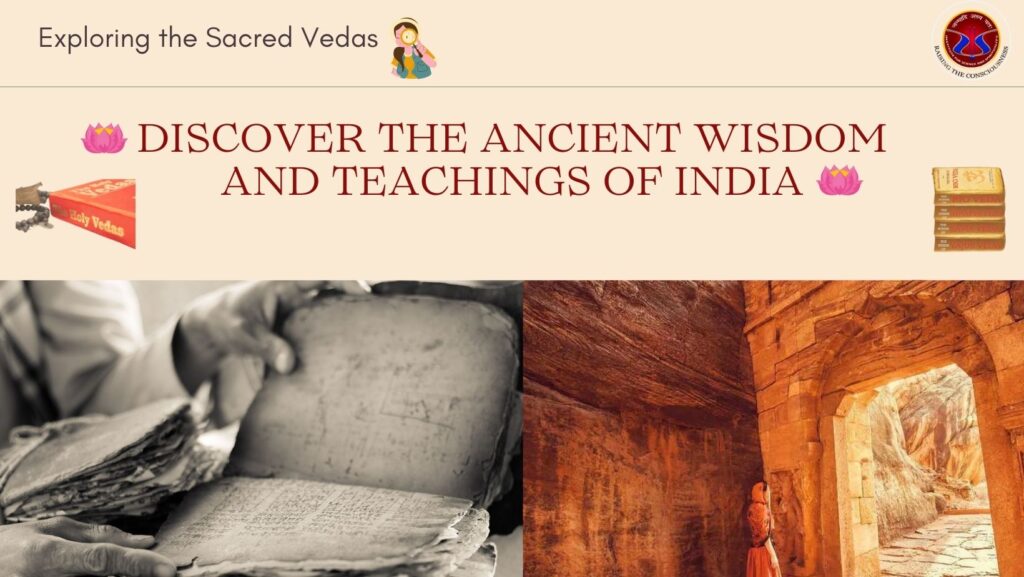Table of Contents:
- Introduction
- The Rig Veda: The Foundation of Vedic Knowledge
- The Yajus Veda: The Manual of Rituals
- The Sama Veda: The Veda of Melodies
- The Atharva Veda: The Book of Magical Formulas
- Comparative Analysis
- Beyond the Vedas: Exploring the Chaturdasa Vidya Sthanas
- The Vedas and Modern Life
- Conclusion
Introduction
The Vedas represent more than mere written words; they encapsulate the essence of timeless knowledge that has been a guiding force in shaping the rich tapestry of Indian civilization over countless centuries. Serving as the foundational scriptures of Hinduism, these ancient texts are not just repositories of spiritual wisdom but also embody a profound insight into the intricate workings of existence and the divine realm. Divided into four distinct categories – Rig, Yajur, Sama, and Atharva – each Veda plays a vital role in contributing to the holistic philosophy that underpins Hindu beliefs.
Moreover, alongside these revered scriptures are the Chaturdasa Vidya Sthanas, elucidating upon what is known as the Fourteen Abodes of Knowledge. This comprehensive body of wisdom encompasses an extensive array of subjects ranging from sacred rituals to celestial studies like astrology, further enriching and expanding upon the spiritual reservoir contained within the Vedas. This blog embarks on an explorative journey through each Veda, unveiling their essence and their place within the broader spectrum of Indian wisdom, as encapsulated in the Bhagavat Puran Shlok: निगमकल्पतरोर्गलितं फलं शुकमुखादमृतद्रवसंयुतम् | पिबत भागवतं रसमालयं मुहुरहो रसिका भुवि भावुकाः || (The Bhāgavata Purana is the mature fruit of Vedic knowledge, passed down through Śukadeva Gosvāmī. It contains immortal nectar. Enjoy this Bhāgavatam, a ripe desire tree of Vedic literature.)
The Rig Veda: The Foundation of Vedic Knowledge
The Rig Veda, considered the most ancient and pivotal of the four Vedas, consists of poetic hymns that pay homage to different gods while praising the wonders of nature and highlighting the deep bond between humanity and the divine realm. Acting as a spiritual compass, this sacred text provides profound wisdom on how the universe came into existence and delves into the very core of life. Beyond being mere religious verses, these hymns serve as contemplative musings on nature’s marvels, human society’s intricacies, and the vastness of the cosmos, which solidifies its esteemed position within the Chaturdasa Vidya Sthanas. It has a very famous mantra, Gayatri Mantra. The Gayatri Mantra is a universal prayer that is addressed to the divine light of Savitar, the Sun God, to illuminate the intellect.
ॐ भूर्भुवः स्वः तत्सवितुर्वरेण्यं भर्गो देवस्य धीमहि धियो यो नः प्रचोदयात्। (We meditate on that most adored Supreme Lord, the creator, whose effulgence (divine light) illumines all realms (physical, mental, and spiritual). May this divine light illumine our intellect.)
The Yajur Veda: The Manual of Rituals
Noted for its hands-on involvement in ceremonial practices, the Yajur Veda is segmented into two sections known as the ‘Black’ and ‘White’ parts. Each segment meticulously outlines the necessary prose incantations needed to conduct rituals. The composition and substance of this sacred text demonstrate a profound comprehension of the symbolic essence of these ceremonies, which were integral to both the spiritual and communal framework of the ancient Vedic civilization. Its importance transcends mere religious customs, delving into guidance on how to lead a life that aligns with the rhythms of nature and universal order. It has a very famous Shloka – Shanti Path, a powerful invocation for peace. This mantra is often recited at the beginning or end of a prayer session or religious ceremony to seek peace and harmony for all beings.
ॐ सह नाववतु। सह नौ भुनक्तु। सह वीर्यं करवावहै। तेजस्वि नावधीतमस्तु मा विद्विषावहै॥ ॐ शान्तिः शान्तिः शान्तिः॥ (May the Lord protect and bless us. May He nourish us, giving us strength to work together for the good of humanity. May our learning be brilliant and purposeful. May we never turn against one another. Om peace, peace, peace.)
The Sama Veda: The Veda of Melodies
The Sama Veda, distinguished for its focus on melodic chants, represents a compilation of musical tunes originating from the Rig Veda. This sacred text holds great importance in elevating spiritual encounters through the art of music, thereby shaping the evolution of traditional Indian musical forms. Through its utilization of sound and harmonies, the Sama Veda establishes a profound link between the universe and those who worship, underscoring its vital position within the realm of ancient Vedic wisdom. Understanding the full meaning may require considering how these elements are used in music and rituals. Much of the Sama Veda focuses on honoring the deities Agni (associated with fire) and Indra (a warrior god and king of gods) during different aspects of the Soma rituals. For example, a simple yet profound verse dedicated to Agni, often featured in the Sama Veda, praises Agni as the priest and the one who carries the offerings to the gods:
अग्न आ याहि वीतये गृणानो हव्यदातये | नि होता सत्सि बर्हिषि || (O Agni, come to the feast, you who are praised, to the offering of this sacrifice. You are the priest, be seated on this sacred grass.)
The Atharva Veda: The Book of Magical Formulas
The Atharva Veda sets itself apart from other Vedas by delving into the ordinary aspects of existence using incantations, enchantments, and ceremonial practices. It covers a wide array of topics, including physical well-being and extending life span, as well as matters related to affection and wealth, thus granting us insight into the typical routines of ancient Indian society. Its significant impacts on Ayurvedic medicine and the ancient science of Vedic astrology highlight its tangible significance, illustrating its multifaceted use within the Chaturdasa Vidya Sthanas – the fourteen branches of knowledge in Vedic literature. One of the well-known mantras from the Atharva Veda is for health and healing, invoking the power of medicinal herbs to heal the sick.
भेषजं वर्चसाम् भेषजं जीवितायाम् | अर्वाग् भेषजं सन्तानानाम् भेषजम् || (A remedy for brilliance, a remedy for life, A remedy to ward off, a remedy for offspring.)
Comparative Analysis
The four Vedas, although each with its unique emphasis, hold overlapping concepts that underscore the significance of seeking knowledge, exploring spirituality, and recognizing the interconnectedness of all living beings. Every Veda contributes to a multifaceted comprehension of Vedic principles, showcasing the rich tapestry of ideas within Indian philosophy. Together, these ancient texts offer a profound well of wisdom that has steered numerous generations in navigating both their spiritual journeys and practical endeavors.
Beyond the Vedas: Exploring the Chaturdasa Vidya Sthanas
The Chaturdasa Vidya Sthanas go beyond the Vedas, encapsulating a diverse spectrum of wisdom that encompasses not only the Upavedas and Vedangas but also a rich tapestry of philosophies and sciences. These intricate branches of knowledge lead us into profound explorations of life’s multifaceted dimensions, delving into realms such as governance, warfare, health, and architecture. They serve as a testament to the boundless reservoir of Vedic insight, offering not only supplementary lessons to the Vedas but also practical adaptations and applications across various spheres of existence and societal structures.
The Vedas and Modern Life
The enduring knowledge found in the Vedas and the Chaturdasa Vidya Sthanas continues to hold significance in our modern world by providing profound guidance on how to live a life that is well-rounded, morally sound, and personally satisfying. These ancient texts stress the importance of living in harmony with the natural world, fulfilling one’s responsibilities, and seeking enlightenment through learning. By embracing these teachings, today’s society can move towards a more sustainable future filled with tranquillity and wellness. The adaptation of this timeless wisdom for contemporary challenges highlights the universal applicability and lasting impact of Vedic philosophy.
A Journey Through the Vedas: The Divine Essence Everywhere
The excerpt from the Bhagavad Gita (Chapter 15, Verse 15) encapsulates the profound essence of Vedic wisdom by illustrating the omnipresence of the divine within the human heart and the universe, “सर्वस्य चाहं हृदि सन्निविष्टो मत्त: स्मृतिर्ज्ञानमपोहनं च। वेदैश्च सर्वैरहमेव वेद्यो वेदान्तकृद्वेदविदेव चाहम्॥” This verse conveys that the divine presence is inherent in all beings and is responsible for memory, knowledge, and their absence. It stresses that this truth must be understood by all who seek knowledge through the Vedas. This verse highlights a fundamental belief in the existence of a supreme consciousness within each person, influencing cognitive faculties and guiding one towards discerning ultimate truths. By studying the Vedas, individuals embark on a path towards enlightenment where they are led to realize the divine essence pervading both themselves and the universe. This realization fosters a deeper understanding of self, cosmos, and their interconnectedness, ultimately leading to liberation and supreme joy. The journey through these ancient Indian scriptures serves as a transformative process of self-discovery where individuals are guided to recognize and nurture the divine spark within them, fostering a life rooted in wisdom, harmony, and unity with universal consciousness.
Conclusion
The Vedas, serving as the cornerstone of Vedic wisdom, and the Chaturdasa Vidya Sthanas, representing a vast array of Indian intellectual traditions, provide profound revelations about existence, cosmic order, and spirituality. These teachings are abundant in spiritual insights, philosophical depth, and practical wisdom that have significantly influenced the development of Indian society and remain a source of inspiration for people worldwide. The preservation and examination of these ancient scriptures and knowledge frameworks transcend mere historical reverence; it is a means to enhance the prospects of tomorrow by ensuring that the sacred teachings of the Vedas persist in guiding future generations with clarity and enlightenment.



